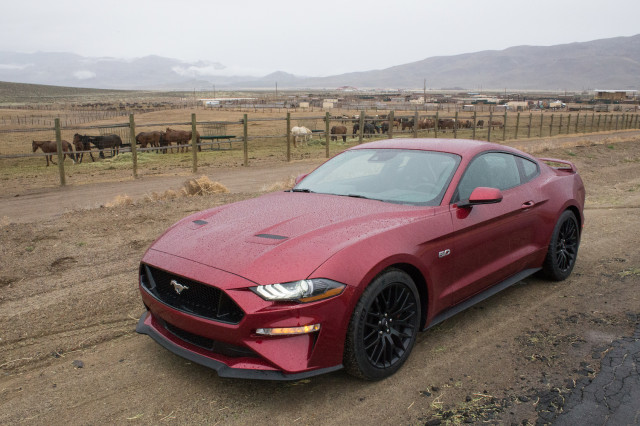Wild horses, part two: Horses with no names

2018 Ford Mustang GT at Palomino Valley’s National Wild Horse and Burro Center
Nobody needs a mustang, but the United States of America owns thousands of them.
Some roam the dun-colored hills outside the indistinct suburbia that shrouds Reno, Nevada, out past the legion Banks of America and Starbucks and Home Depots, past the dreary model homes at Shadow Ridge. Misty gray sky smudges it all together before the houses thin, then turn to trailers, then disappear as they give way to mountains that frame the Palomino Valley.
That poetic name fits poetic land. A dozen miles away from gaudy neon life, this part of Nevada speaks for a vast silent geographic majority, thinly populated by scrub grass, cold enough for snow in May.
Tesla’s Gigafactory sits to the east, a looming threat to gas-powered muscle cars like the Mustang GT that sidles up to the fence at Palomino Valley’s National Wild Horse and Burro Center.
One of the horses on the other side of the rails notices its approach. The horse casts a wary eye, lifts his head to examine this other Mustang and the animal noises that come from its chuffing V-8.
DON'T MISS: Wild horses, part one: The misfits
In a not so wild West, mustangs have become luxury objects only a few can afford. They no longer make sense as transportation, or as work machines. Protected since 1971 by federal statute, the mustang’s numbers have tripled in just a few decades.
The open range can’t sustain them all, so the federal government gathers them and then houses them on slivers of Bureau of Land Management property snipped from the corners of the millions of acres the agency administers.
Here at Palomino Valley, wild horses lose their freedom, in exchange for a chance at better, if more confined lives.
The walnut brown horse that pokes his head through the barbed-wire fence doesn’t know where it is, or what will happen next, but it has food and water, and other wild horses to follow.
* * *

Jeremy Wilhelm at Palomino Valley’s National Wild Horse and Burro Center
Jeremy Wilhelm reported for duty at Palomino Valley in 2013, before his beard had grown long and streaked with gray. In an instant, thousands of horses became his wards, and he became their protector—their case worker.
Jeremy grew up in Deming, New Mexico—”a city kid who played basketball,” he recalls. His great-grandfather started a livestock show and rodeo in nearby El Paso, Texas. Jeremy worked summers for him, and went from zero interest in the rodeo to working with one of the rodeo horsemen. After school, four years of service on the USS Seattle, and two deployments to the Middle East, he came back home, and bought and trained his first horses. Then he heard about Palomino Valley, applied, and got hired by the BLM.
The BLM houses wild horses and burros on ranches scattered across the West. Here in Palomino Valley, they put up animals that come in from the range lands of Nevada and eastern California, a swath of 27 million acres that’s five times larger than Los Angeles. Palomino Valley is the largest publicly operated facility of its kind in the country, home to more than a thousand wild horses at any given time.
A century ago, millions of mustangs roamed the West. Through the 1950s, ranchers slaughtered the nuisance horses at will until only about 20,000 roamed free. In 1950, the mustang stood as a symbol of the vanishing West, much like the Mustang today stands as a symbol for the vanishing appeal of gasoline.
Thanks to the tireless work of Velma “Wild Horse Annie” Johnston, wild horses and burros have been protected from slaughter since 1971. Wild horses and burros have been able to breed, almost unchecked, for nearly 50 years. The horses have few natural predators. Competition for food has receded; livestock grazing is down 30 percent on federal land since 1971. Herds can double in size in five years.
Birth control isn’t simple. An effective vaccine only lasts about a year, and horses must be located and darted and tracked. Wild horses are skittish and frightened of humans and machinery by nature; they’re prey animals.
“Our eyes sit on the front of our head,” Jeremy says. “That makes us predators, so they're automatically afraid of us.”
Today, about 80,000 wild horses roam BLM ranges. The BLM may have 100,000 horses to handle by next year.
This west is no longer wild; it’s case-managed.
Email This Page